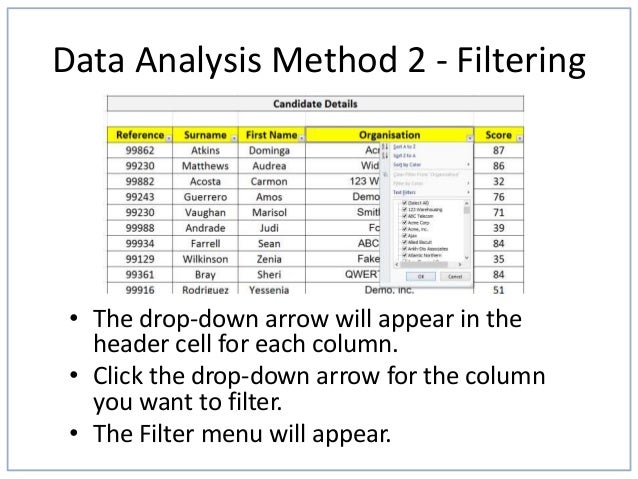

- HOW TO USE DATA ANALYSIS IN EXCEL 2010 CORRELATION SOFTWARE
- HOW TO USE DATA ANALYSIS IN EXCEL 2010 CORRELATION TV
Subsequent operations on that column will assume that the only allowable values for that column are the ones originally imported,Īnd assigning a new text value will introduce a warning and produce an NA (missing value). The default behavior of data import functions in R (e.g., read.csv) is to automatically convert a text column into a factor. The third “benefit” can lead to unintended or unexpected behavior:
HOW TO USE DATA ANALYSIS IN EXCEL 2010 CORRELATION SOFTWARE
The possible values a given categorical variable can take are enforced in the software (like an enum). Storage and indexing can be optimized (as in a relational database). In particular, ordinal data can be represented as an ordered.factor in R, preserving a user-specified ordering in charts, tables, and models. Knowing that data is categorical can act as a signal telling software how statistical procedures, such as producing a chart or fitting a model, However, explicit identification of data as categorical, as distinct from text, does offer some advantages: Software engineers and database programmers may wonder why we even need the notion of categorical and ordinal data for analytics.Īfter all, categories are merely a collection of text (or numeric) values,Īnd the underlying database automatically handles the internal representation. More important, the data type for a variable determines how software will handle computations for that variable. In fact, data science software, such as R and Python, uses these data types to improve computational performance. The data type is important to help determine the type of visual display, data analysis, or statistical model. It turns out that for the purposes of data analysis and predictive modeling, Why do we bother with a taxonomy of data types?
HOW TO USE DATA ANALYSIS IN EXCEL 2010 CORRELATION TV
Numeric data comes in two forms: continuous, such as wind speed or time duration, and discrete, such as the count of the occurrence of an event.Ĭategorical data takes only a fixed set of values, such as a type of TV screen (plasma, LCD, LED, etc.) or a state name (Alabama, Alaska, etc.).īinary data is an important special case of categorical data that takes on only one of two values, such as 0/1, yes/no, or true/false.Īnother useful type of categorical data is ordinal data in which the categories are ordered an example of this is a numerical rating (1, 2, 3, 4, or 5). There are two basic types of structured data: numeric and categorical. Synonymsĭichotomous, logical, indicator, boolean OrdinalĬategorical data that has an explicit ordering. SynonymsĮnums, enumerated, factors, nominal, polychotomous BinaryĪ special case of categorical data with just two categories of values (0/1, true/false). Synonymsĭata that can take on only a specific set of values representing a set of possible categories. Synonymsĭata that can take on only integer values, such as counts. ĭata that can take on any value in an interval. The field of exploratory data analysis was established with Tukey’s 1977 now-classic book Exploratory Data Analysis. Tukey forged links to the engineering and computer science communities (he coined the terms bit, short for binary digit, and software), and his original tenets are suprisingly durable and form part of the foundation for data science. He proposed a new scientific discipline called data analysis that included statistical inference as just one component. Tukey ( Figure 1-1) called for a reformation of statistics in his seminal paper “The Future of Data Analysis”.

This chapter focuses on the first step in any data science project: exploring the data.Įxploratory data analysis, or EDA, is a comparatively new area of statistics.Ĭlassical statistics focused almost exclusively on inference, a sometimes complex set of procedures for drawing conclusions about large populations based on small samples. The main goal of this book is to help illuminate these concepts and clarify their importance-or lack thereof-in the context of data science and big data. These and many other statistical concepts live largely in the recesses of data science. Introducing key ideas of experimental design and maximum likelihood estimation. Fisher, in the early 20th century, was a leading pioneer of modern statistics, Modern statistics as a rigorous scientific discipline traces its roots back to the late 1800s and Francis Galton and Karl Pearson. In contrast to the purely theoretical nature of probability, statistics is an applied science concerned with analysis and modeling of data. Probability theory-the mathematical foundation for statistics-was developed in the 17th to 19th centuries based on work by Thomas Bayes, Pierre-Simon Laplace, and Carl Gauss. As a discipline, statistics has mostly developed in the past century.


 0 kommentar(er)
0 kommentar(er)
